CAMPING IN YOSEMITE NATIONAL PARK
With beautiful lush green valleys, wild rivers, and towering granite peaks, camping in Yosemite National Park offers so many places to explore! If you’re wondering what the current rules are for visiting the park, if you need a day pass, and how to find a campsite, we’ve got you covered!
In this blog, we’ll cover:
- Highlights of Yosemite
- The Park’s History and Sacred Origins
- Getting to Yosemite National Park
- Reservations and Day Passes
- Where to Stay- Hotels, Lodging, Camping in Yosemite National Park
- Rock Climbing in Yosemite National Park
- Other Activities in Yosemite National Park
- Spotting Bears and Other Wildlife
When you’re camping in Yosemite National Park, or even staying at one of the many park lodges, you’ll get the opportunity to see the park during quieter hours. This means more trails, wildlife, waterfalls, and spectacular views all to yourself!
In addition, Yosemite is the premier destination for rock climbers. So if you want early access to climbs on El Capitan, the Sentinel, or Half Dome, or just want to sit back and watch the magic happen, camping in Yosemite is the way to go.
Let’s dive into Yosemite National Park, and why it remains one of our favorite places on the planet!
1. Highlights of Yosemite
In addition to rock climbing and camping in Yosemite National Park, there are so many activities to enjoy. Here are just a few of the highlights that make this park so special:
- The iconic view from ‘Tunnel View’
- Hiking to the top of Yosemite Falls
- The park’s history and its first inhabitants
- Wildlife viewing in the meadows
- Skiing and snowboarding (yes, there’s a ski resort in Yosemite!)
- Swimming and kayaking in Tenaya Lake
You’ll need a car to get here, but once you arrive you can take the shuttle system or hike to almost all places we’ve included below. First, if you haven’t packed for a road trip lately, bookmark our road trip checklist to view later to ensure you’ve got everything!
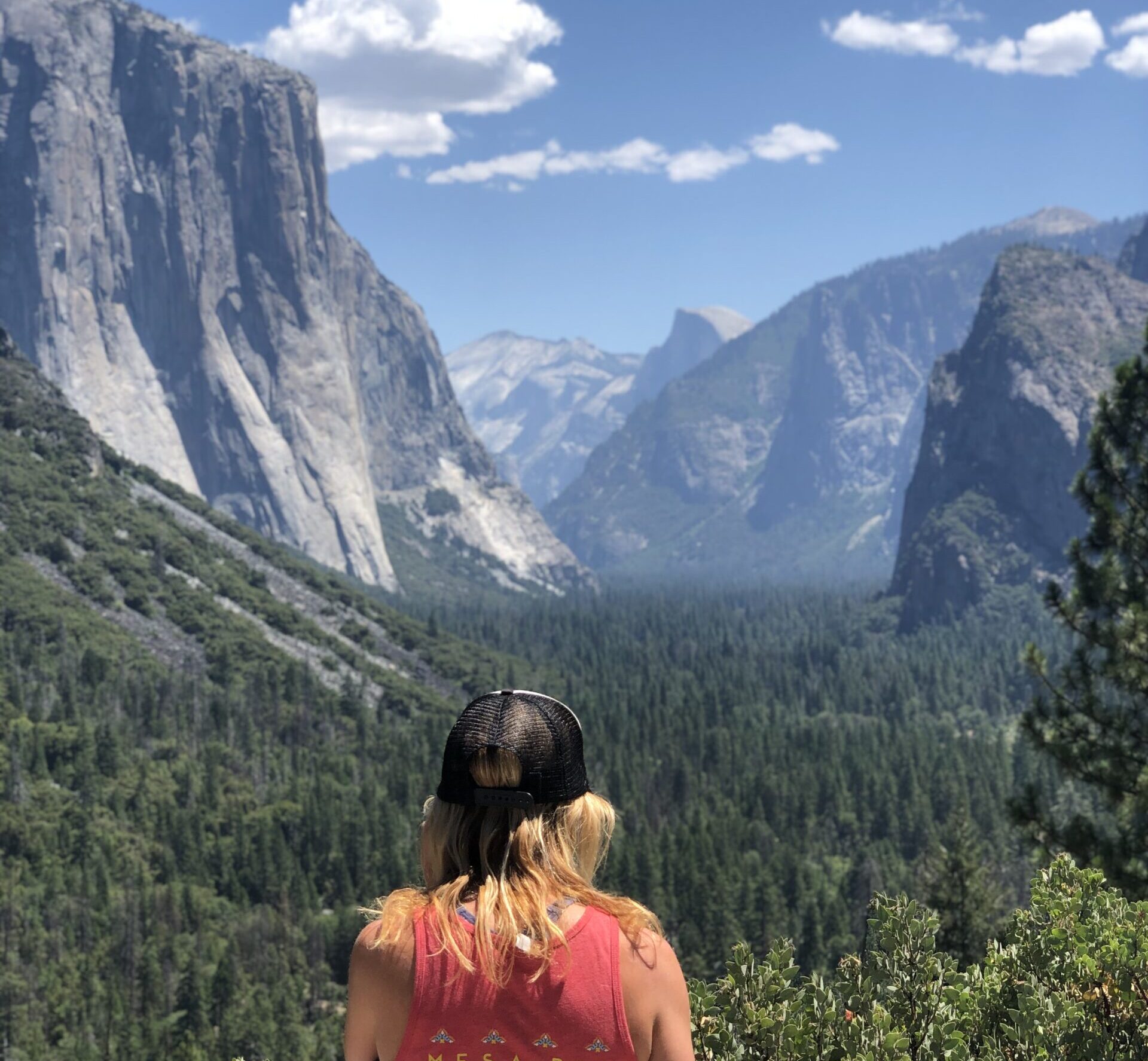
2. The Park’s History and Sacred Origins
Yosemite National Park’s breathtaking landscapes have drawn visitors for centuries, but its origins stretch far beyond its designation as a national park in 1890. Long before the U.S. government claimed stewardship, the Ahwahneechee people, a branch of the Southern Sierra Miwok, thrived in the Yosemite Valley for thousands of years, living in harmony with the land.
Other tribes, including the Mono and Paiute, also had deep connections to the region, shaping its trails, meadows, and cultural history. Therefore, the park was not “founded” by settlers but taken through violent conflicts during which Indigenous people were forced from their homeland.
There are several places in the park where you can learn more about the indigenous history of Yosemite:
- The Yosemite Museum
- The Indian Village of the Ahwahnee
- Mariposa Museum and History Center
Today, the descendants of these tribes continue to fight for recognition and the right to protect their ancestral lands, reminding us that Yosemite’s true history is one of resilience, not discovery.
3. Getting to Yosemite National Park
Yosemite via the eastern Sierras, Route 395, and Tioga Pass
To reach Yosemite National Park from the Eastern Sierras, head north on 395 from June Lake, Mammoth, or Bishop. Or head south on 395 from Reno or Lake Tahoe. If you haven’t read our Eastern Sierras Road Trip blog, take a peek at that first!
You’ll summit Tioga Pass, at almost 10,000ft, and enter the park through the Tioga Entrance. Keep in mind, Tioga Pass and Tioga Road both close by late October and do not open up until June or later when the snow has been cleared.
In addition, both the Tioga Entrance and Tioga Road, in general, are much quieter compared to Yosemite Valley, and you can easily reach the following spots:
- Tuolumne Meadows
- Tenaya Lake
- Olmsted Point
- Clouds Rest
Yosemite via the south entrance, Big Oak Flat, or Arch Rock entrances
Planning to visit Yosemite Valley where you’ll find Half Dome and El Capitan? Well, then your best bet is to enter at the South Entrance or on the west side of the park at either Big Oak Flat or Arch Rock entrances.
The west side of Yosemite and its entrances are open year-round, with road closures only when there’s snow. On this side of the park, you’ll enjoy El Capitan and Half Dome, plus:
- Yosemite Falls
- Glacier Point
- Tunnel View
- Mariposa Grove- home to Giant Sequoias!
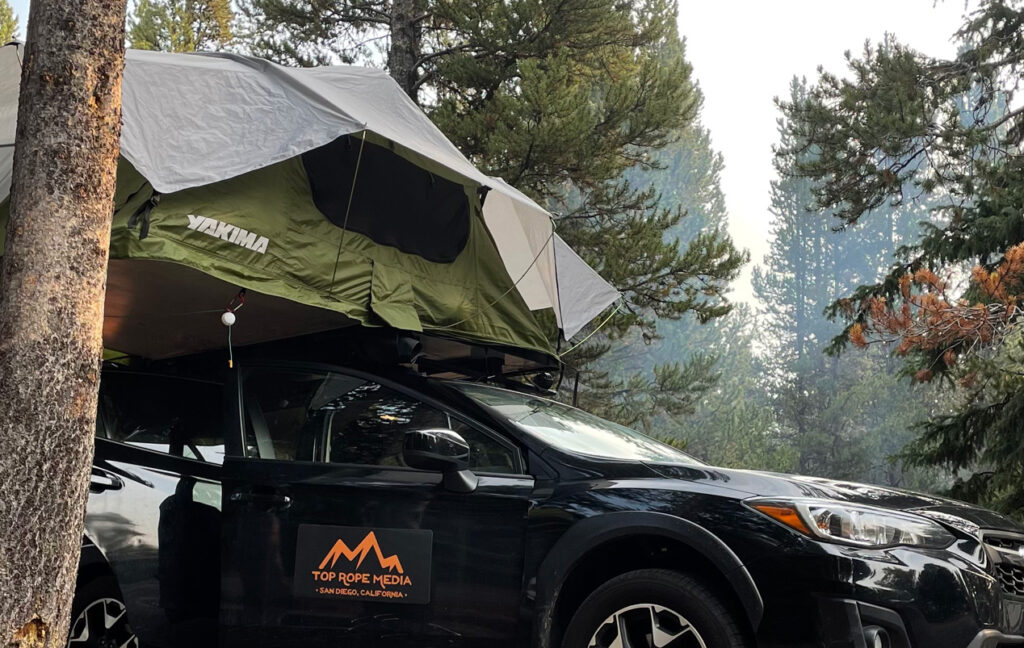
Camping in Yosemite in a tent is more fun if you’re off the ground!
4. Yosemite National Park reservations and day passes
To visit Yosemite National Park, reservations are still needed during the summer, busy holiday weeks, and weekends between May through October. Do keep in mind that there are often long waits to drive in. If you are camping in Yosemite National Park and already have a reservation, or if you’ve booked a room at one of the lodges, you do not need a day pass to enter.
It’s best to check the Yosemite National Park main website a few weeks before your plan to arrive to see if you need to make a reservation or apply for a day pass.
5. where to stay: Hotels, Lodging and Camping in Yosemite National park
There are 12 campgrounds in Yosemite National Park, and all can be booked through Recreation.gov. The most popular ones are located in Yosemite Valley, including the infamous Camp 4.
Keep in mind, it is illegal to camp overnight in a pullout or day-use area within Yosemite National Park. Therefore if you don’t find a campsite, we’ve also included a few Yosemite lodging options below. In addition, there are also towns nearby including El Portal, Fish Camp, Bass Lake, and Oakhurst, the latter being the largest, with plenty of hotels, shops, and restaurants. However, driving to and from the park everyday can take hours. Especially if you want to hit all the highlights- Tuolumne Meadows, Yosemite Valley, and Glacier Point.
Get familiar with the shuttle system, and the distances/travel time between each part of the part you plan to visit. This can save you hours on trying to find parking, especially during the summer or over holiday weekends.
Campgrounds in Yosemite National Park
- Wawona Campground– near South Entrance, 1 hour from Yosemite Valley
- Bridalveil Creek Campground– near Glacier Point and Mariposa Grove, and Badger Pass Ski Area
- Upper & Lower Pines Campgrounds– in Yosemite Valley near market, wifi, and lodges
- Tamarack Flat, Hodgdon Meadow & Crane Flat Campgrounds– close to Big Oak Flat Entrance, 30mins from Yosemite Valley
- Camp 4– known as the climber’s camp, there is a lottery to get a campsite here
- White Wolf Campground– 2 miles off Tioga Road, near White Wolf Lodge and the Hetch Hetchy Reservoir
- Yosemite Creek Campground– 5 miles off Tioga Road (remote)
- Porcupine Flat Campground– primitive camping, over an hour to Yosemite Valley
- Tuolumne Meadows Campground– best campground off Tioga Road, close to services, and Tuolumne River
All Yosemite National Park campgrounds can be reserved through Recreation.gov.
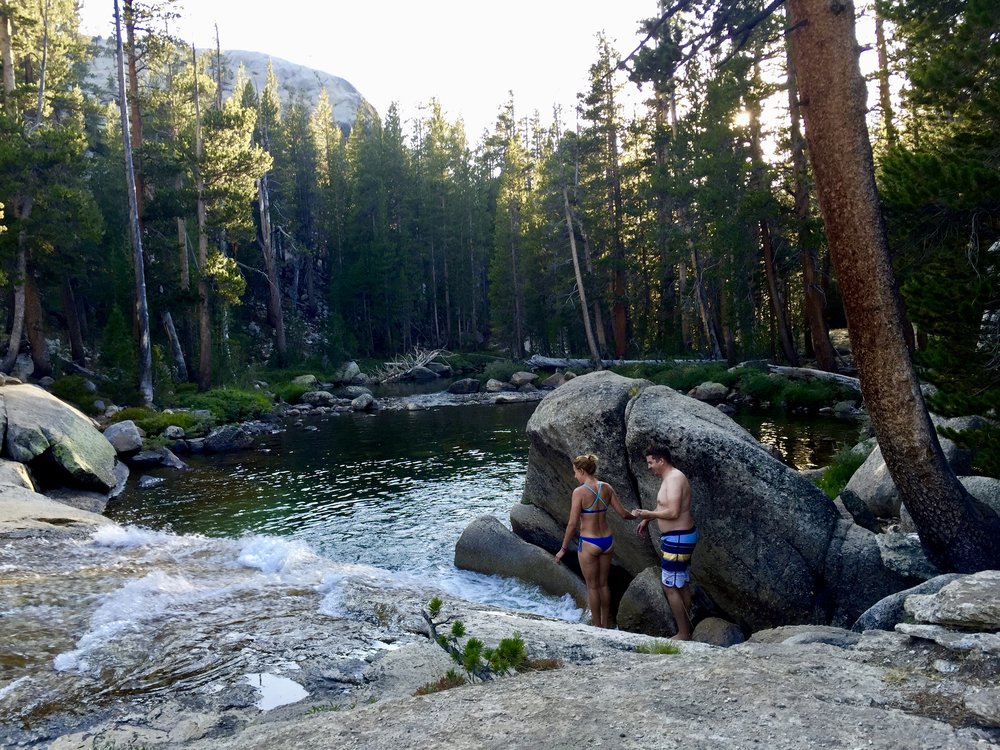
After a big hike or rock climbing, nothing feels as refreshing as jumping into the Tuolumne River! And there are lots of great natural pools for swimming adjacent to the Tuolumne Meadows Campground!
Hotels and lodging in Yosemite National Park
If camping in Yosemite National Park is not your thing, no worries, there are more posh accommodations. And there are even glamping options for those who want the camping experience, but not all the hassle! Here are a few options we love:
- Ahwahnee Hotel– the crown jewel of National Park lodges. Worth visiting even if you don’t stay!
- Yosemite Valley Lodge
- Tuolumne Meadows Lodge
- Housekeeping Camp
- Curry Village– pre-set tents with beds, showers, restaurant, coffee
- Wawona Hotel– gorgeous old hotel at South Entrance
- White Wolf Lodge– a few miles off Tioga Road. Rustic cabins and glamping options!
- Yosemite West– lots of hotel and lodging options and close to Badger Pass Ski Area
All hotels and lodges can be booked through several travel sites, including TravelYosemite.com
6. Rock Climbing in Yosemite National Park
When it comes to rock climbing, Yosemite National Park is the premier climbing destination in the U.S. and its become increasingly popular thanks to films like Free Solo and the Dawn Wall. You could spend your whole life climbing here and not discover all that the area has to offer.
We always skip the crowded Yosemite Valley and head for Tuolumne Meadows. Here you’ll find less crowded climbing on solid alpine granite, and a greater chance of scoring a campsite!
In addition, besides Half Dome and El Capitan, Yosemite National Park has hundreds of trad and sport routes, and dozens of boulder problems. Classic climbing areas in Tuolumne Meadows include the big triple crown of Tenaya Peak, Matthes Crest and Cathedral Peak, plus dozens of routes on Fairview Dome, Lembert Dome, Puppy Dome…Plus you can swim in the Tuolumne River or Tenaya Lake when you finish up!
Learn to Rock Climb in yosemite
If you want to try rock climbing in Yosemite for the first time, get your kids involved, or maybe you know how to climb but don’t have the gear, go with a guide or organize a group outing. Yosemite Mountaineering School and Guide Service, located in Curry Village, is one of the only guiding operations allowed to operate in the park.
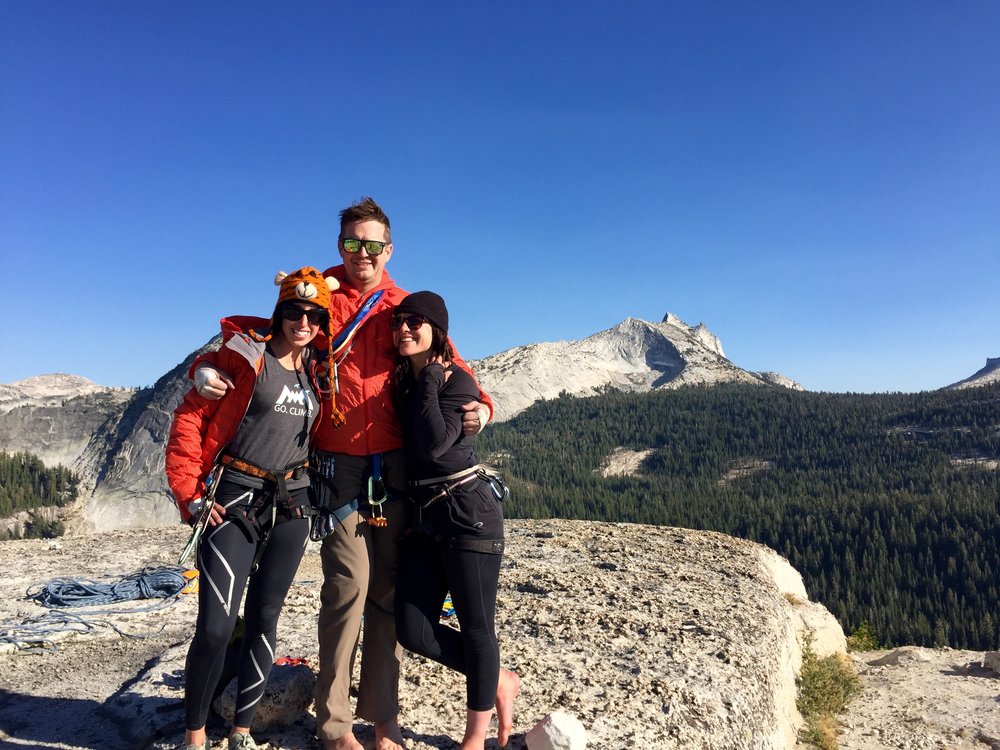
High above the valley floor, rock climbing in Tuolumne Meadows provides incredible views and fewer crowds.
Nearby Climbing Areas Outside Yosemite National Park
Not ready for trad climbing in Yosemite and seeking more sport routes? Well with great weather and low humidity, the Bishop area is a climbing mecca year-round.
Other areas with good climbing and short approaches for beginners and families? We like Mammoth and June Lake. Read about all of these places in our Eastern Sierras blog!
Best Time Of Year To Climb or watch rock climbers
For rock climbers, the colder and drier the rock is, the better. This is because cold, dry weather produces more friction between your skin and the rock. However, you’ll be able to climb or observe climbers year-round in Yosemite Valley. And remember, Tuolumne Meadows access will be limited to May through October.
For the chance to catch many of the pro climbers that have called Yosemite Valley home, head to El Capitan Meadow. Remember to pack your binoculars or a scope to see climbers from around the world scaling El Capitan’s big walls from morning to night.
In addition, the views of El Capitan at night are spectacular as the climbers’ headlamps illuminate their path upwards. Or light up their bivy sacks as they settle in for the evening high up on the wall!
7. OTHER activities in Yosemite National Park
Not a climber? Well, there are still plenty of activities to try when you’re camping in Yosemite National Park:
- Hike Yosemite Falls, a 7.2-mile round trip to the top of the falls
- Rent a bike in Curry Village and ride around the Valley!
- Take the paved trails to view Vernal, Bridalveil & Nevada Falls
- Go skiing, tubing or snowboarding at Badger Pass Ski Area
- Fish the Merced River in El Capitan Meadow or the Tuolumne River. Get a California fishing permit first!
- Take in the view at Clouds Rest!
- Swim, SUP, fish, or kayak on the gorgeous Tenaya Lake
- Apply for a permit to hike Half Dome. This strenuous 14-16 mile round-trip hike gains 4,800 feet, the steepest, most dangerous section is the last 400ft. where you’ll be assisted by cables.
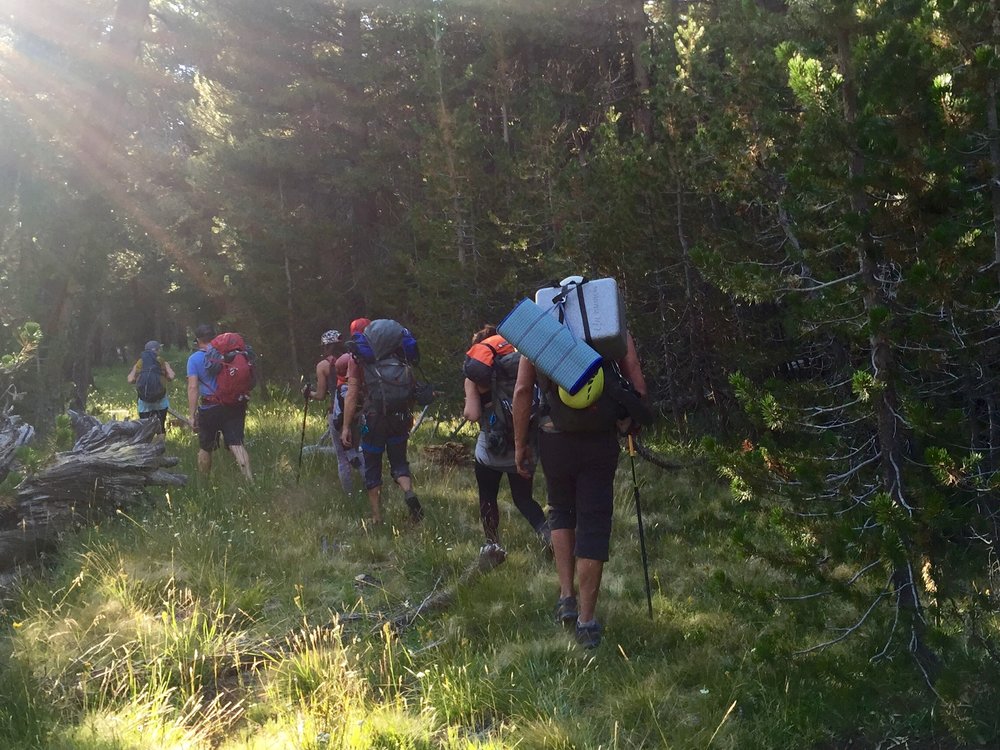
Backpacking through Yosemite National Park towards Mount Whitney is a popular starting point for those that want to experience the John Muir Trail or the Ansel Adams Wilderness!
8. Spotting Bears and Other Wildlife in Yosemite National Park
There is an abundance of wildlife in Yosemite National Park. From marmots to coyotes, big horn sheep to mule deer, and then of course the 300-500 black bears that call Yosemite home. The best time to spot wildlife is early mornings or at sunset in the meadows and during the quieter months in the park.
The place you don’t want to encourage wildlife to visit is your campsite. Therefore all campsites in Yosemite National Park are equipped with food lockers or bear boxes.
Tips on keeping a bear-free campsite and staying bear-aware:
- Use the bear box! Put all items with a scent in the bear box. This includes soap, toothpaste, and sunscreen.
- Do not leave cooking utensils, dishes, or stoves on your picnic table. It will guarantee unwanted visitors. And not just a black bear. Squirrels, chipmunks, marmots, and deer will raid your campsite for any items that look and smell like a treat!
- Keep a safe distance from bears if you spot one. Especially if it’s a mother and her cubs. 300ft. is what’s recommended. Resist the urge to approach for a better photo.
camping in Yosemite national park: final thoughts
If you’ve never been camping in Yosemite National Park, add it to your adventure list! Want more adventure tips and travel destinations? Check out some of our other travel blogs here:
- Traveling to Cuba
- Backpacking in the Wind River Range, Wyoming
- Grand Teton National Park
- San Diego: America’s Finest City
- Camping in Sequoia National Park & Kings Canyon
To learn more about what we do on the regular, follow Top Rope Media’s adventures on Instagram, Facebook or Twitter.
Until next time, happy camping!
– Meredith McConvill, Top Rope Media